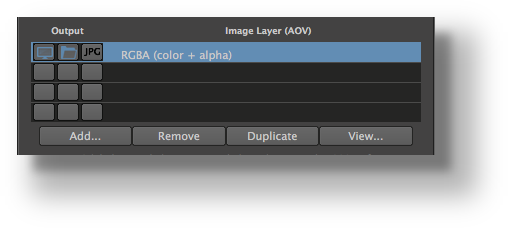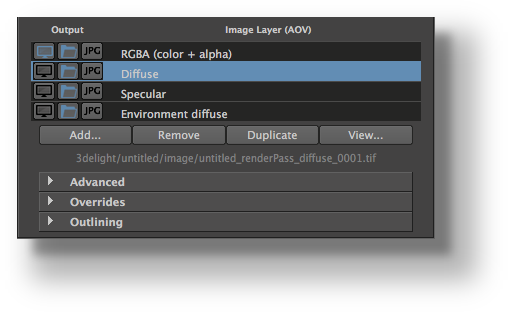Overview
Using the Image Layers group of attributes the user specifies one or several layers of images to output simultaneously from the rendering process. Each can be set to be displayed on screen (in a window) or be saved to a file or both. By default, the Image Layers group of attributes is setup to output only one image layer: the RGBA components representing the main image, also commonly referred to as the Beauty. And it is setup to be outputted on screen.
It is possible to add any number of layers, each set to output any complementary values to the Beauty image. These are derived from variables computed inside shaders and are commonly called Arbitrary Output Variables (AOVs). Example of layers are: depth values associated to the Beauty image, original color of surfaces (without the effect of the lighting), the specular and diffuse shading components of the Beauty image. These layers can be useful for compositors to have many options while composing the final image. Refer to Supported AOVs for further details on supported AOVs.
Layers can not only be generated using different AOVs, they can also:
- From different camera angles. This is very powerful for fast simultaneous multi-camera rendering (for 3D stereo for example).
- Contain a different subset of objects in the scene. These are more advanced options and are described in the Layers Advanced.
All the layers are rendered simultaneously. Adding many layers do not generally increase rendering time significantly. This is different and not to be confused with the 3Delight for Maya functionality of Render Passes. Those are processed sequentially and can produce totally different output from one pass to another.
The Image Layers group
Global Options
Specifies the default file location for the image layers. By default, the location is based on the scene name, the render pass name and the AOV name. See File Path Expressions for details on how it is possible to construct relative paths and paths containing dynamically expanded tokens.
Default Image Format
Specifies the default file format for the image layers, including the bit depth. The default is 8-bit TIFF files. Many formats are supported and each have specific requirements as to what bit depths are supported. Refer to Image File Formats for more details.
Batch Output Mode
Each image layer (AOV) have an output toggle controlling wether it should be saved to file (this is explained in details in the following section). Since these toggle may be manipulated frequently while working interactively and they may be forgotten in a OFF position while sending the rendering on a render farm using the Maya Batch command line, the Batch Output Mode controls wether these toggles should be ignored (overridden) when rendering in batch mode. This option is useful to make sure all image layers are saved when rendering using the Maya Batch command line, regardless of the status of the toggle. The options are:
Enable file output as selected | Indicates to output the image layer to file (in batch mode) only if the corresponding output toggle is selected. This is the default and it follows the same behaviour as in interactive mode. |
Enable all file output and selected JPEG | Indicates to ignore (override) the output toggle and request that all image layers be saved to file when in batch mode. With regard to the automatically generated JPEG version, only those that are selected will be outputted to file (meaning the Batch Output Mode have no overriding effect to the JPEG output toggle and those are outputted only if enabled, wether in batch or interactive mode). |
Each image layer (AOV) have a toggle controlling wether it should be saved on file or not (this is explained in details in the following section). The Interactive Output Mode allows to globally control the behaviour of the output toggles. The options are:
Enable file output as selected | Indicates to output the image layer to file (in interactive mode) only if the corresponding file output toggle is selected. This is the default behaviour. |
Disable file output | Indicates to disable the output of the image layer to file (in interactive mode). Both the regular and JPEG file output toggles will be ignored. This is useful to work interactively only by looking at the image layers on screen and ignore the file output toggle (and possibly assigning them to be used mostly in batch mode). |
Enable file output only for selected displays | This is an hybrid option. While working interactively, one may be interested to output to file only those image layers that he is actively working on; those that are selected to be displaying on screen. With this option, the image layers will be saved to file only if the display on screen toggle in selected. |
List of Layers (AOVs)
By default, the list is populated with only one image layer, the RGBA ("Beauty") layer, and additional layers can be added. Each layer can be selected to be displayed on screen and/or be saved to file. They can be saved in the specified format and also simultaneously in JPEG (similar in concept to a digital camera where one can select to save a RAW image and/or a JPEG). The output for each layer is controlled using the the three toggles present at the beginning of each layer in the list:
display on screen | Enables the display of the image layer in a window on screen. The selection of which window (i.e. which application) |
file output | Enables the output of the image layer to file (referred to as the standard file). The file location and format is specified |
jpeg output | Enables the output of the image layer as a JPEG. The file location is the same as specified for the standard file, |
If all three toggles are selected, the image layer will be outputted simultaneously in a screen window, on file and as a jpeg. If none are selected, the image layer is inactive.
Below the list there are four buttons:
Add...
For adding layers. A separate dialogue will pop for selecting the AOV for that layer.
Note: There is currently a problem with that dialog: when selecting a new AOV in the AOV Selector and pressing OK, the ones already present in the list of Layer (AOV) are removed. As a temporary work around, simply make sure you select these AOVs you have already present in your list of layers (AOV) in the AOV Selector before you press OK. This way they will remain. (You can make multiple selections in the AOV Selector using the modifier keys).
Remove
Select a layer (AOV) in the list to remove it. Note that the RGBA ("Beauty") layer can not be removed.
Duplicate
Select a layer (AOV) in the list to duplicate it. You can then change some of the per layer attributes for the duplicated layer (otherwise you simply end up with exactly the same AOV without any differences to it).
View...
Select a layer (AOV) to view it. This opens the Image Filename for hat layer in a viewing application. Refer to The 3Delight Preferences for how to select which application should be launched.
Per Layer Attributes
When selecting a layer in the list of layers, the following list of attributes are available. These are per-layer attributes. Advanced collapsable layout. Refer to the Layers Advanced for a description of these advanced attributes.
Group of attributes for a specific Layer
Image Filename
To override the Default Image Filename. The options are "Default" to use (not override) the Default Image Filename and "Custom" to specifies a custom filename for the selected layer. When default is selected, the complete expanded filename is listed just below (expanded from the token).
File Format
To override the Default ImageFormat. The options are "Default" to use (not override) the Default Image Format and "Custom" to specifies a custom file format, including the bit depth.
Bit Depth
Specifies how many bits to use per layer component. The available bit depth values are:
Some image formats have specific requirements as to what bit depths are supported. Refer to Image File Formats.
| Option | Description |
|---|---|
| 8 bit integer _________________ | The image will use 8 bits integer values for each component, with values ranging between 0 (black) and 255 (white). This corresponds to a quantization of 0, 255, 0, 255 for zero, one, min and max, respectively, and a dither value of 0.5. This is the default value. |
| 16 bit integer | The image will use 16 bits integer values for each component, with values ranging between 0 (black) and 65535 (white). This corresponds to a quantization of 0, 65535, 0, 65535 for zero, one, min and max, respectively, and a dither value of 0.5. |
| 16 bit float | The image will use 16 bits float values for each component. Currently, only the ‘exr’ driver supports this format. This corresponds to a quantization of 0, 0, 0, 0, and a dither value of 0 (identical to ‘32 bit float’); the display driver receives a pixel type specification through an option. |
| 32 bit float | The image will use 32 bits float values for each component. This corresponds to a quantization of 0, 0, 0, 0, and a dither value of 0. |
| Custom... | All images are rendered internally in 32-bits float format. Quantization is the process of assigning integer values to these floating-point values. Some usual preset values are available in the Bit Depth attribute. If they do not include the needed variation, it is possible to specify custom quantization values by selecting this menu entry. Upon selection, a dialog pops up, displaying the current bit depth settings. It allows specification of values for Zero, One, Min, Max and Dither amplitude. Zero is the black point, while One is the white point. These two values can be different from the Min and Max values if you need to have under-exposed or over-exposed values. An example set of values for 12 bits output with standard dithering would be: 0, 4095, 0, 4095, 0.5 An example set of values for 16 bits output with a white point at 4K that prevents over-exposed pixels from being clamped to the white value, would be: 0, 4095, 0, 65535, 0.5 |
| Other Custom entries | The option menu will also list all custom bit depths defined for all of the current image layers. |





